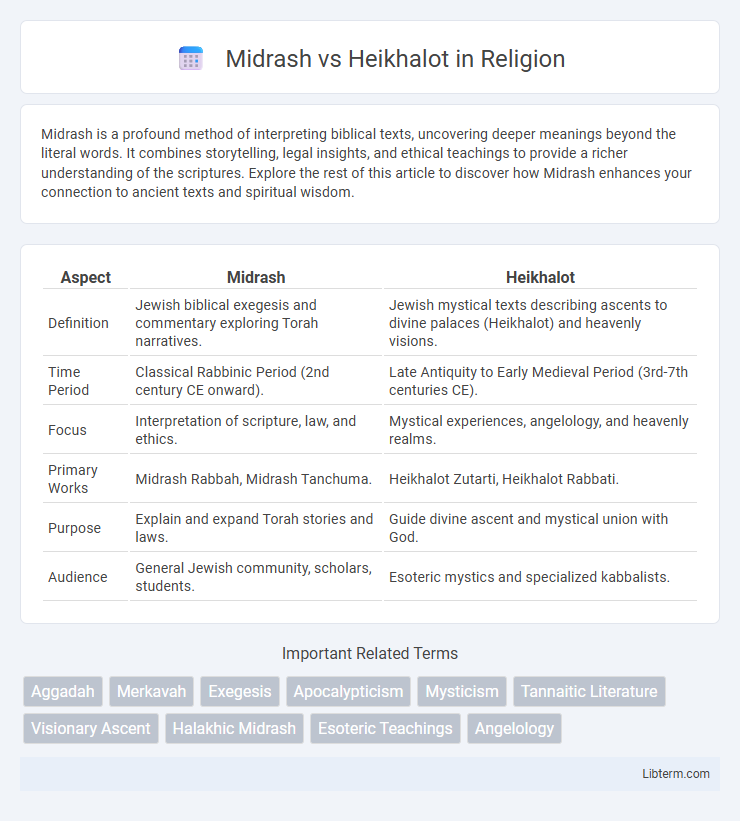Midrash is a profound method of interpreting biblical texts, uncovering deeper meanings beyond the literal words. It combines storytelling, legal insights, and ethical teachings to provide a richer understanding of the scriptures. Explore the rest of this article to discover how Midrash enhances your connection to ancient texts and spiritual wisdom.
Table of Comparison
| Aspect | Midrash | Heikhalot |
|---|---|---|
| Definition | Jewish biblical exegesis and commentary exploring Torah narratives. | Jewish mystical texts describing ascents to divine palaces (Heikhalot) and heavenly visions. |
| Time Period | Classical Rabbinic Period (2nd century CE onward). | Late Antiquity to Early Medieval Period (3rd-7th centuries CE). |
| Focus | Interpretation of scripture, law, and ethics. | Mystical experiences, angelology, and heavenly realms. |
| Primary Works | Midrash Rabbah, Midrash Tanchuma. | Heikhalot Zutarti, Heikhalot Rabbati. |
| Purpose | Explain and expand Torah stories and laws. | Guide divine ascent and mystical union with God. |
| Audience | General Jewish community, scholars, students. | Esoteric mystics and specialized kabbalists. |
Introduction to Midrash and Heikhalot
Midrash refers to a genre of ancient Jewish biblical exegesis that explores deeper meanings of scripture through narrative, legal interpretations, and homiletic teachings. Heikhalot literature, by contrast, centers on mystical visions and heavenly palaces, depicting esoteric journeys of the soul and divine realms within early Jewish mysticism. Both texts emerged between the Second Temple period and early Rabbinic Judaism, providing complementary perspectives on Jewish theology and spirituality.
Historical Context and Origins
Midrash originated during the Second Temple period and developed extensively in the early Rabbinic era, serving as a method of biblical interpretation and legal exegesis that deepened Jewish textual understanding. Heikhalot literature emerged between the 3rd and 7th centuries CE, rooted in early Jewish mysticism and describing visionary ascents to heavenly palaces (heikhalot) and divine realms. While Midrash focuses on explicating scripture and law within historical and communal contexts, Heikhalot texts emphasize esoteric mystical experiences and heavenly secrets central to Jewish mystical traditions.
Defining Midrash: Purpose and Methods
Midrash serves as a method of biblical interpretation aimed at uncovering deeper meanings, legal principles, and ethical lessons within the Hebrew Scriptures, often utilizing narrative expansion and allegory. Its purpose is to bridge gaps in the biblical text by providing explanations and moral guidance through homiletic stories and legal exegesis. Methods of Midrash include parables, wordplay, and imaginative retellings that reveal theological insights and address practical questions faced by Jewish communities.
Understanding Heikhalot Literature
Heikhalot literature explores mystical experiences and heavenly ascents, emphasizing visionary journeys to divine palaces, often depicted with rich, symbolic imagery. Unlike Midrash, which primarily provides narrative expansions and legal exegesis on biblical texts, Heikhalot texts delve into esoteric knowledge and secret rites aimed at spiritual elevation. Understanding Heikhalot literature involves grasping its complex themes of angelic hierarchies, ritual purity, and the quest for divine knowledge within early Jewish mysticism.
Core Themes in Midrash Texts
Midrash texts emphasize biblical interpretation and ethical teachings, exploring the deeper meanings of scripture through narrative expansions and legal exegesis. Core themes include covenantal relationships, divine justice, and the moral responsibilities of the Jewish people. These texts often address communal identity and spiritual growth, contrasting with the mystical and visionary focus of Heikhalot literature.
Mystical Motifs in Heikhalot Texts
Heikhalot texts feature intricate mystical motifs centered on ascents through heavenly palaces, divine throne visions, and angelic hierarchies, emphasizing experiential encounters with the divine presence. Unlike Midrash, which primarily interprets Torah narratives, Heikhalot literature focuses on esoteric knowledge and ritual practices aimed at mystical union and spiritual empowerment. These texts reveal detailed descriptions of spiritual realms and transformative journeys that serve as a foundation for early Jewish mysticism.
Literary Structure: Narrative vs. Mystical Journey
Midrash is characterized by its rich narrative structures that expand biblical texts through storytelling, legal interpretation, and homiletic exposition, emphasizing ethical teachings and communal values. In contrast, Heikhalot literature centers on detailed mystical journeys through divine palaces, featuring visionary experiences and esoteric rituals aimed at spiritual ascent and union with God. The literary structure of Midrash facilitates engagement with scripture through dialogue and elaboration, while Heikhalot texts use symbolic and visionary frameworks to guide mystical exploration.
Theological Differences and Emphases
Midrash emphasizes narrative interpretation of the Hebrew Bible, focusing on ethical teachings, divine justice, and human responsibility, whereas Heikhalot literature centers on mystical visions, angelology, and the ascent to heavenly palaces, reflecting an experiential approach to divine presence. Midrashic theology often highlights God's immanence and covenantal relationship with Israel, while Heikhalot texts underscore transcendence and esoteric knowledge attained through secret rituals. These distinct emphases reveal divergent modes of engaging with the divine: Midrash through legal and moral reflection, Heikhalot through mystical union and celestial exploration.
Influence on Jewish Thought and Practice
Midrash shapes Jewish thought by providing interpretative narratives that expound biblical texts, influencing legal rulings and ethical teachings in rabbinic Judaism. Heikhalot literature, centered on mystical and esoteric experiences of the divine palace, impacts Kabbalistic practices and meditative traditions within Jewish spirituality. Together, they contribute distinct yet complementary dimensions to Jewish theology, law, and ritual life.
Comparative Analysis: Midrash and Heikhalot
Midrash and Heikhalot literature both offer rich layers of Jewish mystical thought, yet differ significantly in focus and form; Midrash emphasizes exegetical narratives that elucidate biblical texts through allegory and legal interpretation, shaping rabbinic tradition and ethical teachings. Heikhalot texts, rooted in Merkavah mysticism, concentrate on visionary journeys exploring divine palaces and angelic hierarchies, providing esoteric descriptions of the heavenly realms and divine presence. While Midrash serves as a foundational tool for scriptural understanding within normative Judaism, Heikhalot writings advance speculative and experiential mysticism, illustrating divergent approaches to divine revelation and spiritual ascent.
Midrash Infographic

 libterm.com
libterm.com